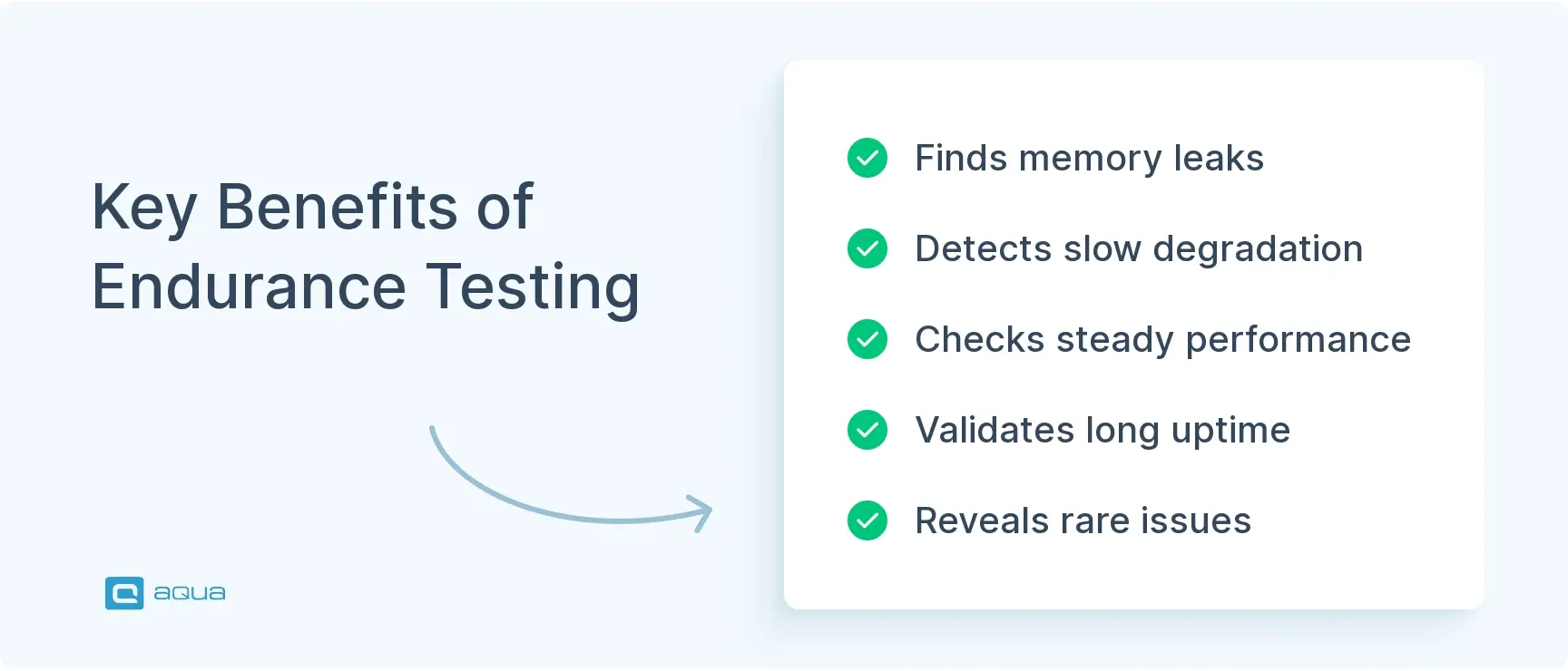What is Endurance Testing?
Endurance testing (sometimes called soak testing) is a form of performance testing that evaluates how your software performs under expected load conditions over an extended period. Unlike other tests that might run for minutes or hours, endurance tests often run for days or even weeks.
The core purpose is to catch those sneaky bugs that only surface after prolonged use. That might include memory leaks, resource degradation, and performance slowdowns that happen gradually rather than immediately.
Here’s what makes endurance testing different from its QA cousins:
- Duration: While load tests might run for a few hours, endurance tests run for extended periods – think 24+ hours minimum
- Focus: Tests specifically look for issues that develop over time rather than immediate breaking points
- Workload: Uses consistent, expected loads rather than trying to break the system with peak traffic
- Goals: Aims to find memory leaks, resource exhaustion, database connection problems, and gradual performance degradation
It’s like the difference between sprinting and running a marathon. Load testing checks if your app can handle a quick sprint of heavy traffic. Stress testing pushes it to the breaking point. But endurance testing? It checks if your app can keep running day after day without getting winded. When comparing endurance testing vs load testing, remember that load testing focuses on immediate performance under specific loads, while endurance testing reveals how systems behave during extended operations.
The Importance of Endurance Testing
You should know that endurance testing takes time and resources. So why bother?The simple answer: because the cost of skipping it can be massive. A detailed answer? Let’s break it down:
Why Endurance Testing Matters
- Catches memory leaks that would eventually crash production systems
- Identifies performance degradation issues before users do
- Reveals database connection problems that only appear after extended use
- Prevents resource exhaustion scenarios (CPU, memory, disk space)
- Builds user trust by ensuring consistent performance regardless of session length
Industries Where Endurance Testing Is Non-Negotiable
There are some industries where you just can not ask “Do I need endurance testing?” because how critical and how costly (even fatal) this ignorance can be. Let’s look at some of them:
- Banking & Financial Services: Systems handling transactions must maintain integrity over weeks of operation
- Healthcare: Patient monitoring systems cannot afford downtime or degraded performance
- E-commerce: Shopping platforms during sales events or holiday seasons
- Infrastructure & Utilities: Systems monitoring critical infrastructure
- Communication Platforms: Messaging and video conferencing apps that run continuously
The Cost of Skipping Endurance Tests
In 2021, AWS had a huge outage that broke parts of the internet for hours; Netflix, Alexa, and even Amazon deliveries stopped working. The problem didn’t happen all at once; their systems slowly got overwhelmed after running for a while. That’s exactly the kind of issue endurance testing is meant to catch: problems that show up only after hours of use. If they had tested how their systems behaved over time, they might’ve avoided a very public meltdown.
Endurance Testing Features
Unlike stress tests or load tests that push systems to their limits, endurance testing is all about the long game. It’s designed to uncover issues that only surface after hours or even days of continuous use. Here’s what sets effective endurance testing apart:
- Extended Runtime: Tests run continuously for days or weeks, not hours
- Consistent Load Profile: Maintains steady, realistic user loads rather than extreme peaks
- Comprehensive Monitoring: Tracks a wide range of metrics throughout the entire test duration
- Resource Usage Analysis: Focuses on identifying patterns of increasing resource consumption
- Performance Degradation Detection: Looks for gradual slowdowns rather than immediate failures
- Database Behaviour Observation: Monitors how database performance evolves over time
- Memory Leak Detection: Specifically designed to catch memory that isn’t properly released
The most valuable feature is the ability to identify problems that would never appear during shorter tests. That mysterious crash that happens every Tuesday afternoon? An endurance test might be your only shot at reproducing and fixing it before it hits production. For a complete understanding of endurance testing with example scenarios, consider how banking applications must process transactions continuously without degradation for weeks.
Types of Endurance Testing
Endurance testing isn’t just “run it and wait.” What matters is how you run it, because different systems break in different ways over time. The kind of long test you run depends on what you’re trying to uncover. And different scenarios call for different approaches:
| Type | Description | When to Use |
|---|---|---|
| Constant Load | Maintains the same load level throughout the entire test | For baseline performance evaluation and memory leak detection |
| Step Load | Gradually increases load in steps, maintaining each level for extended periods | For systems with predictable traffic patterns that vary throughout the day |
| Random Load | Varies the load randomly within defined parameters | For systems with unpredictable usage patterns |
| Open-Loop | Generates transactions at predefined rates regardless of system response | When testing how the system handles backlog under consistent input |
| Closed-Loop | Adjusts transaction generation based on system response times | When simulating realistic user behavior that adapts to performance |
| Scalability Endurance | Tests how the system performs over time as resources are added or removed | For cloud-based applications with auto-scaling features |
| Recovery Endurance | Tests how the system recovers from failures during extended operation | For high-availability systems that must maintain uptime |
The right approach depends on your specific application and what you’re trying to validate. A banking system might need constant load testing to ensure transaction processing remains stable, while an e-commerce platform might benefit more from step load testing to simulate daily traffic patterns.

When to Perform Endurance Testing
Timing matters when it comes to endurance testing. It’s not something you just tack on at the end, as we discussed above, that could be fatal. It is when you run it can make all the difference. Here are the key moments to consider:
- During major architectural changes – When you’ve modified how the system handles resources
- Before high-traffic events – Pre-holiday season for retail, before tax season for financial software
- After performance optimisation – To verify improvements don’t introduce long-term issues
- Prior to production deployment – As part of your final validation gate
- When introducing new hardware or infrastructure – To ensure compatibility and performance
- After significant code refactoring – Especially involving memory management or database access
- When investigating user-reported performance degradation
- On regular schedules for mission-critical systems – Quarterly endurance testing cycles
Don’t wait for problems to appear in production. The best time to run endurance tests is when you have time to fix any issues discovered, not when customers are already affected.
When it comes to ensuring software reliability, endurance testing is your marathon runner in the QA race. But marathons require the right equipment and strategy to succeed. This is where aqua cloud steps in as your ideal training partner. With its AI-powered test management capabilities, aqua helps you organise and execute comprehensive test suites that can be monitored for consistency over time. Unlike basic testing tools, aqua’s centralised platform keeps all your test assets, results, and analytics in one place – essential when tracking performance patterns across extended testing periods. The platform’s custom dashboards provide real-time insights into test execution status, helping you spot gradual degradation issues before they become critical failures. Plus, aqua’s seamless integrations with popular project management, automation and performance tools ike Jira, Azure DevOps, Selenium, Jenkins, etc. ensure you can coordinate your endurance testing efforts within a unified ecosystem instead of juggling multiple disconnected solutions.
Transform your long-running tests from chaotic marathons into well-orchestrated journeys with aqua cloud
How to Perform Endurance Software Testing
Endurance testing is about more than just running your system for days. It’s about learning how it holds up over time; quietly tracking down slow memory leaks, creeping CPU usage, and anything else that might surface after long hours of normal use. Here’s how to do it right, one step at a time:
1. Define success criteria: Before you run anything, figure out what you’re actually testing for. Is it memory stability over 72 hours? Consistent response times over a weekend? Define:
- The minimum duration your test needs to run
- What “healthy” performance looks like (set clear thresholds)
- The specific metrics you’ll monitor during the test
2. Prepare your test environment: To get meaningful results, your test environment should mirror production as closely as possible. Make sure to:
- Use the same system configuration, scale, and data
- Set up monitoring tools to collect detailed performance data
- Pre-load your database with realistic, production-like data
3. Design test scenarios: Design user behaviour that reflects how people actually use your system. This means:
- Simulating common user journeys
- Using a steady workload model (constant, stepped, or variable)
- Adding realistic think times between actions to mimic natural delays
4. Execute the test: Now it’s time to launch the test and let it run.
- Start with a quick performance baseline
- Let the test run for the full planned duration
- Avoid interacting unless something breaks critically
5. Monitor and collect data: The real value of endurance testing is in the data it reveals over time. Track things like:
- CPU, memory, disk I/O, and network usage
- Database query performance and connection health
- Response times at regular intervals
- Error rates and log messages
6. Analyse results: Once the test is done, it’s time to dig into the data. You’re looking for trends, not just spikes.
- Compare metrics from start to finish
- Watch for growing resource usage or memory leaks
- Identify sudden slowdowns or unstable behavior
- Review database size and index health
7. Document and report findings: Don’t just send a wall of numbers. Tell the story behind the data.
- Create graphs and visual summaries
- Document any anomalies or performance concerns
- Offer clear recommendations for what to fix
8. Fix issues and retest: Once issues are addressed, validate your fixes with shorter targeted retests or even another full endurance run if needed. This is where endurance testing becomes part of your long-term software quality strategy.
Good endurance testing takes time and care. It’s about spotting the subtle signs of trouble before they reach your users. As you can see, the goal isn’t to push your system until it crashes; it’s to make sure it doesn’t, no matter how long it runs.
Challenges in Endurance Testing
Of course, like every testing type and methodology, endurance testing isn’t without its hurdles. Here are the common challenges you’ll face and how to overcome them:
Time Constraints
Long tests can lock down environments for days, slowing down everything else. Teams often don’t have the luxury to babysit these runs, and test failures late in the cycle can waste huge amounts of time.
How to manage it:
- Run tests during weekends or off-peak development periods
- Use dedicated test environments to avoid blocking others
- Automate monitoring and set alerts so you don’t need constant oversight
Environment Stability
Even small infrastructure issues can ruin an endurance test. A brief server hiccup, an unexpected update, or a nightly job running in the background can corrupt test conditions and force you to restart.
How to stay stable:
- Use isolated, production-like environments with dedicated resources
- Automate service recovery and health checks
- Prevent scheduled jobs or external changes during test windows
Data Volume Overload
Endurance testing produces a mountain of data; logs, metrics, performance counters and most of it won’t be useful. Without a plan, you’ll drown in numbers and miss what actually matters.
How to handle it:
- Use sampling and limit logging to what’s truly important
- Set up dashboards to highlight trends and anomalies
- Archive or rotate logs automatically to avoid crashes
Interpreting Results
Not every fluctuation is a problem. Some metrics drift naturally over time, so the real challenge is knowing when a slow rise in memory or CPU is acceptable, and when it’s a red flag.
How to make sense of it:
- Establish baseline metrics before the test starts
- Define clear thresholds for acceptable degradation
- Focus on identifying consistent upward trends, not random spikes
Test Interruptions
The longer a test runs, the more likely it is that something will interrupt it, like a server reboot, a network timeout, or someone accidentally killing a process.
How to prevent test restarts:
- Implement checkpointing so tests can resume after interruptions
- Build retry logic into your test scripts
- Communicate test schedules clearly across teams to avoid surprises
Resource Drain
Running tests for 72 hours can hog machines and delay other work. Many teams don’t have hardware to spare, especially for repeated test cycles.
How to use resources efficiently:
- Use cloud infrastructure that can scale up and down as needed
- Schedule endurance tests for nights or weekends
- Target specific subsystems when full-stack testing isn’t possible
Endurance testing pays off when it’s done right, but only if you plan for the real-world bumps along the way. You’re not just testing your product. You’re testing your environment, your processes, and your patience.
Best Practices for Endurance Testing
To get real value out of endurance testing, you need more than a long runtime. What you need is purpose, realism, and smart monitoring. Let’s walk through what that looks like in practice.
As mentioned above, start by defining clear success criteria. Before the test even begins, the team should agree on what counts as a pass or a fail. For example, if memory usage increases no more than 10% after 72 hours and response times stay under 2 seconds at the 99th percentile, that’s your bar. Without this clarity, it’s hard to know what the test is actually proving.
Next, prepare your environment with production-like data volumes. Running an endurance test on a half-empty database or minimal user input won’t tell you how the system behaves under real conditions. Scale your test data to match what your live system handles daily, not what’s easiest to set up.
Everything should be automated, not just the test execution itself, but the monitoring and result collection too. You shouldn’t have to manually dig through logs or graphs for every run. Tools should be collecting CPU usage, memory trends, error rates, and latency at regular intervals from the start.
During the test, make sure you’re monitoring all system layers; not just your application, but also the underlying infrastructure, network traffic, and database performance. Sometimes the slowdown starts in the DB layer long before the front-end shows any signs of trouble.
Also, avoid the trap of watching only averages. Pay close attention to percentile-based metrics, especially the 95th and 99th percentile response times. These often show performance degradation long before the average gives any hint.
Implement progressive monitoring. In the early hours of the test, track metrics more frequently, say, every 5 minutes. As the system stabilises, you can scale back the monitoring frequency to reduce data noise while still catching trends.
Make sure you log everything with timestamps. That includes system events, test actions, and external triggers. It’ll help immensely later when you’re trying to correlate a performance dip with a database spike or a GC event.
Resist the urge to interrupt tests too early. Many bugs or degradation symptoms only show up after very specific durations or thresholds; sometimes it’s hour 48, not hour 6, that reveals the real issues.
To keep results clean and actionable, isolate your test environment. If someone pushes a build mid-test or the environment shares infrastructure with another team’s sprint, your data becomes worthless.
If your production environment runs database maintenance activities like nightly backups or index rebuilding, your test should include them too. The goal is to recreate real-world behaviour, including background jobs and scheduled operations.
Finally, go one step further and test recovery scenarios. Midway through the endurance run, restart a service or simulate a network glitch. This shows whether the system bounces back gracefully or spirals into failure.
One critical habit that’s often missed: document the baseline before the test starts. Without a known “good” state to compare against, all those logs and metrics mean little. You need that anchor to measure drift, degradation, or improvement.
When planning endurance tests as part of your performance testing, treat them as real-world simulations, not lab experiments. The more realistic the scenario, the more valuable the insight.
Examples of Endurance Testing
Let’s look at real-world examples of endurance testing in action:
1. Banking Transaction System
- Test Duration: 7 days
- Scenario: Continuous processing of 100 transactions per second
- Success Criteria: No more than 5% performance degradation over 7 days
- Issue Found: Connection pool leakage causing gradual slowdown after 3 days
2. E-commerce Platform
- Test Duration: 48 hours
- Scenario: Simulated shopping patterns including browsing, cart additions, and checkouts
- Success Criteria: Consistent page load times (1.2–1.4 seconds) throughout the test period
- Issue Found: The Product image caching mechanism is consuming increasing memory
3. Healthcare Patient Monitoring
- Test Duration: 14 days
- Scenario: Continuous streaming of patient vitals from thousands of simulated devices
- Success Criteria: Zero alert delays greater than 3 seconds
- Issue Found: Log rotation process causing brief processing pauses
4. Mobile App Backend
- Test Duration: 72 hours
- Scenario: User authentication, content browsing, and social interactions
- Success Criteria: Consistent API response times (180–220 ms) throughout test period
- Issue Found: Session tracking mechanism causing memory bloat
5. IoT Data Processing Pipeline
- Test Duration: 5 days
- Scenario: Processing sensor data from 50,000 simulated devices
- Success Criteria: Consistent throughput and query performance (850–950 requests/sec, avg query time 120–140 ms) throughout test period
- Issue Found: Time-series database index fragmentation causing gradual query slowdown
Each example shows how endurance testing catches issues that would be missed by shorter tests, issues that would eventually impact real users. These examples demonstrate the true test of endurance that systems must undergo to ensure reliable performance in production environments.
Endurance Testing vs Other Types of Performance Testing
We know the best practices, examples, and challenges. Now it comes down to comparing it to the other, similar testing methods:
| Aspect | Endurance Testing | Load Testing | Stress Testing | Spike Testing |
|---|---|---|---|---|
| Duration | Days to weeks | Hours | Minutes to hours | Minutes to hours |
| Primary Goal | Find issues that appear over time | Validate performance under expected load | Find breaking points | Test response to sudden traffic surges |
| Load Pattern | Steady, realistic load | Gradual increase to target load | Increasing until failure | Sudden extreme load spike |
| Focus Areas | Memory leaks, resource exhaustion, degradation | Response times, throughput | System recovery, failure points | Recovery speed, error handling |
| When to Use | Before production deployment, after major changes | During development cycles | During capacity planning | For systems with unpredictable traffic |
| Success Metrics | Stable performance over time | Meeting SLAs under load | Clean failure and recovery | Maintaining functionality during spikes |
While load testing tells you if your system can handle the expected traffic, endurance testing tells you if it can handle that traffic consistently over time. Stress testing shows you where things break, while spike testing reveals how your system handles sudden changes.
Each type of testing answers different questions about your application’s performance, so a comprehensive strategy usually includes multiple approaches.
Tools for Conducting Endurance Testing
The right tools make endurance testing more manageable. Here are some top options for endurance testing software:
Open Source Tools
1. JMeter
- Perfect for: Web applications and services
- Key features: Distributed testing, extensive protocol support, scriptable test scenarios
- Best used with: InfluxDB and Grafana for long-term monitoring
2. Gatling
- Perfect for: API and microservice testing
- Key features: Code-based test definitions, real-time metrics, excellent reporting
- Best used with: Integration into CI/CD pipelines
3. Locust
- Perfect for: Developer-friendly testing
- Key features: Python-based, distributed, user-behaviour focused
- Best used with: Custom monitoring solutions
4. k6
- Perfect for: Modern cloud applications
- Key features: JavaScript API, CI/CD integration, cloud result storage
- Best used with: Grafana dashboards for visualisation
Commercial Tools
1. LoadRunner
- Perfect for: Enterprise applications
- Key features: Comprehensive protocol support, detailed analysis, integrated monitoring
- Best used with: Performance Centre for test management
2. NeoLoad
- Perfect for: DevOps-oriented teams
- Key features: Easy test design, CI/CD integration, real-time monitoring
- Best used with: Its built-in analytics platform
3. BlazeMeter
- Perfect for: Teams using JMeter who need more scale
- Key features: Cloud-based execution, collaborative features, JMeter compatibility
- Best used with: Jenkins or other CI tools
4. Micro Focus SilkPerformer
- Perfect for: Complex enterprise applications
- Key features: Wide protocol support, visual performance analysis, scenario modelling
- Best used with: Silk Central for test management
Monitoring Tools (Essential Companions)
- Prometheus + Grafana: Open-source monitoring and visualisation
- Dynatrace: AI-powered application performance monitoring
- New Relic: Cloud-based observability platform
- AppDynamics: Application performance management with business insights
The ideal setup combines a load generation tool with comprehensive monitoring. For example, JMeter to create the load, Prometheus to collect metrics, and Grafana to visualise long-term performance trends.
Conclusion
Remember: Your users don’t just use your software for 15 minutes during a test cycle. They rely on it day after day, transaction after transaction. Your testing approach should reflect that reality. The good news? With the right tools, clear processes, and patience, endurance testing doesn’t have to be overwhelming. Start small, automate what you can, and gradually build more sophisticated testing capabilities. So next time you’re tempted to skip that long-running test because of time constraints, ask yourself: can you afford the alternative? Finding a memory leak during a controlled test is always better than explaining to customers why the system crashed during their most critical operations.
As you’ve seen, endurance testing is non-negotiable for creating truly reliable software that performs consistently day after day. But implementing effective endurance testing requires more than just running tests for a long time – it demands organised test management, comprehensive monitoring, and insightful reporting capabilities. aqua cloud delivers exactly these essentials through its all-in-one test management platform. With aqua, you can define clear success criteria for your endurance tests, monitor results through customizable dashboards, and generate detailed reports that reveal subtle performance degradation patterns. The platform’s AI-powered features help you prioritize which tests need extended runs, while its traceability ensures every requirement maintains its performance over time. Organisations using aqua have achieved up to 100% test coverage while cutting test maintenance time by 97% – imagine applying those efficiencies to your endurance testing workflow. Stop letting time-based bugs slip into production when a better approach is just a click away.
Achieve 100% reliable software with systematic, well-managed endurance testing


















